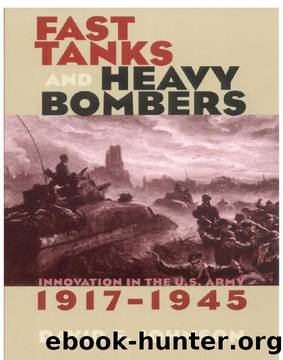Fast Tanks and Heavy Bombers: Innovation in the U.S. Army, 1917â1945 by David E. Johnson

Author:David E. Johnson [Johnson, David E.]
Language: eng
Format: epub
Tags: Military, Political Science, Security (National & International), Strategy, 20th Century, United States, History
ISBN: 9780801467103
Google: SPewtW12cq0C
Publisher: Cornell
Published: 2013-02-15T13:54:39+00:00
[11]
Autonomous Air Power
The Army Air Corps entered the 1930s with the outlines of a concept for the employment of military aviation that promised a decisive role in warfareâstrategic bombardment. For a generation of insurgent air officers who believed that the War Department had repressed the potential of the airplane, strategic bombardment had a seductive appeal. The most important issue for these officers was control of military aviation. As long as the Army Air Corps remained an auxiliary of the ground battle or part of an integrated Army-Navy coast defense effort, a cogent argument for independence from the War Department could not be made. If it could be shown that the aerial weapon had advanced sufficiently to be a decisive offensive force in and of itself, however, a compelling argument existed for the control and development of the technology by air officers.
The theory of strategic bombardment enunciated in the February 1931 Air Corps Tactical School Bombardment Aviation text provided all of the conceptual pieces for a doctrine that gave the Air Corps a strategic, offensive capability beyond the control of ground officers. The text made four fundamental assertions that directed the future development of the doctrine: (1) targets vital to the enemy could be reached only by bombardment aviation; (2) to be effective, bombardment aviation had to be under centralized control; (3) an air force commander would select the targets to be attacked; and (4) bombardment aviation could not be deterred from reaching and destroying its objectives. From these premises, if accepted, flowed an ineluctable conclusion: âBombardment aviationâ¦is the basic arm of the Air Force.â1
In 1931 a number of seemingly unrelated events merged to enable the Air Corps to turn the theory of strategic bombing into a reality. First, an agreement was made between General Douglas MacArthur, Army chief of staff, and Admiral William V. Pratt, chief of Naval Operations, in January regarding coast defense. In the decade since Congress had established spheres of responsibility for the employment of Army and Navy aviation for coastal defense, the two services had sparred intermittently over their respective rights. The Army had a tendency to extend its sea reconnaissance farther from shore than the Navy believed was its proper jurisdiction. The Navy had begun looking to land-based airplanes for missions for which its carrier-based craft were not suited.2 The MacArthur-Pratt agreement was designed to settle these disputes. Henceforth, Naval air forces would be âbased on the fleet and move with it as an important element in performing the essential missions of the forces afloat.â The Army Air Corps would âbe land based and employed as an element of the Army in carrying out its missions of defending the coasts, both in the homeland and in overseas possessions.â3 This agreement provided a War Departmentâsanctioned justification for developing long-range aircraft to fulfill the coastal defense mission. It also gave the Air Corps an approved defensive use for bombers that was acceptable in an era in which the isolationist mood in the country would have made procurement of these airplanes for offensive purposes difficult.
Download
This site does not store any files on its server. We only index and link to content provided by other sites. Please contact the content providers to delete copyright contents if any and email us, we'll remove relevant links or contents immediately.
Learning SQL by Alan Beaulieu(6209)
Weapons of Math Destruction by Cathy O'Neil(6142)
Digital Minimalism by Cal Newport;(5661)
iGen by Jean M. Twenge(5366)
Sapiens by Yuval Noah Harari(5293)
The Age of Surveillance Capitalism by Shoshana Zuboff(4209)
Elon Musk by Ashlee Vance(4027)
Thing Explainer by Randall Munroe(3876)
Apollo 8 by Jeffrey Kluger(3635)
Future Crimes by Marc Goodman(3527)
The Science Book (Big Ideas Simply Explained) by DK(3233)
Who Can You Trust? by Rachel Botsman(3086)
Infinite Energy Technologies by Finley Eversole(2938)
I Live in the Future & Here's How It Works by Nick Bilton(2934)
Steve Jobs by Walter Isaacson(2830)
The Innovators: How a Group of Hackers, Geniuses, and Geeks Created the Digital Revolution by Walter Isaacson(2827)
Dawn of the New Everything by Jaron Lanier(2737)
Chernobyl by Serhii Plokhy(2496)
Ben Franklin's Almanac by Candace Fleming(2464)
